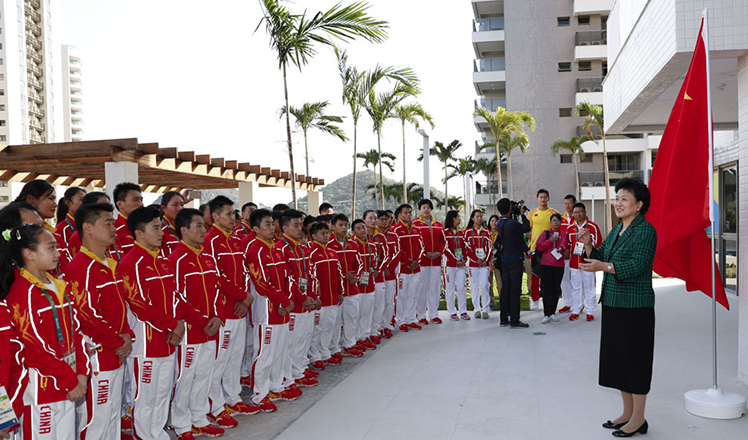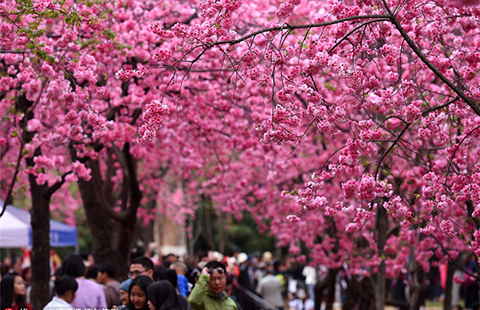Tibet envisioned as hub of Himalayas
Updated: 2016-08-05 08:01
By China Daily(China Daily)
|
||||||||
Tibet could become the cultural, economic and humanitarian hub of the Himalayas and so build a peaceful, cooperative relationship with its South Asian neighbors, experts at the Sixth International Forum on Tibetan Studies have suggested.
Sandwiched between the Silk Road Economic Belt and the 21st Century Maritime Silk Road, Tibet plays a significant role in connecting both initiatives, making it an ideal place for cultures to meet.
"With its beautiful thangka (Buddhist-themed paintings on cloth) and unique clothing, Tibetan culture is very attractive in the Himalayan region. Its influence can radiate through mountains and connect with other South Asian countries," said Lai Shanglong, chief economic commissioner of the United Nations Department of Economic and Social Affairs.
In June last year, China opened a new land route along Himalayan Nathu La Pass for Indian pilgrims to visit the holy sites of Mount Kailash and Lake Mansarovar in Tibet, considered sacred by Hindus and Buddhists. The initiative was universally hailed.
Lai said if China expanded its humanitarian aid projects in Tibet to other South Asian countries - providing practical services such as teaching, repairing buildings and medical treatment - that initiative would also earn praise.
"This would strengthen goodwill toward China in South Asian communities, improve China's image and increase support from neighboring countries," he said.
Trade routes such as the Ancient Tea Horse Road have facilitated economic and cultural interaction for centuries, said Liu Zhifu, director of the South Asia Research Institute at Xizang Minzu University.
Today, the Belt and Road Initiative is breathing new life into Burang, Gyirong, Zham and other ports.
"There is huge demand for high-quality, authentic Tibetan goods, like incense and highland barley products," said Di Fangyao, executive deputy director of the institute.
However, most of the trading goods are not made in Tibet.
"It's high time that Tibet increase its exports of locally produced goods," Di said.
Di also spoke of the importance of infrastructure. The border trading market in Yadong county can open for only six months before the harsh winter sets in.
"I once saw a family of four herding two dozen donkeys carrying cement on their way to Nepal. There is no way the economic and cultural weight of the Belt and Road Initiative can be carried on donkeys," he said.
Zhang Zhihao contributed to this story.
- Fire guts Emirates jet after hard landing; 1 firefighter dies
- Egypt's Nobel-laureate scientist dies of illness in US
- THAAD muscle flexing unmasks anxiety over declining hegemony
- British police say mental health a significant factor in London knife attack
- Paragliding fans fly over Rigi mountain in Switzerland
- DPRK fires 1 ballistic missile into east waters

 Big names train for Rio 2016
Big names train for Rio 2016
 Photo exhibition narrates charm of old Beijing
Photo exhibition narrates charm of old Beijing
 Traditional Tibetan handicrafts kept alive in SW China
Traditional Tibetan handicrafts kept alive in SW China
 Chinese Vice Premier visits Olympic delegation
Chinese Vice Premier visits Olympic delegation
 World's fastest bullet train to start operating next month
World's fastest bullet train to start operating next month
 Jack Ma visits rural school, meets teachers
Jack Ma visits rural school, meets teachers
 Top 8 global market leaders from China
Top 8 global market leaders from China
 After Typhoon Nida, torrential rain hits S. China
After Typhoon Nida, torrential rain hits S. China
Most Viewed
Editor's Picks

|

|

|

|

|

|
Today's Top News
US launches airstrikes against IS targets in Libya's Sirte
Ministry slams US-Korean THAAD deployment
Two police officers shot at protest in Dallas
Abe's blame game reveals his policies failing to get results
Ending wildlife trafficking must be policy priority in Asia
Effects of supply-side reform take time to be seen
Chinese State Councilor Yang Jiechi to meet Kerry
Chinese stocks surge on back of MSCI rumors
US Weekly

|

|







